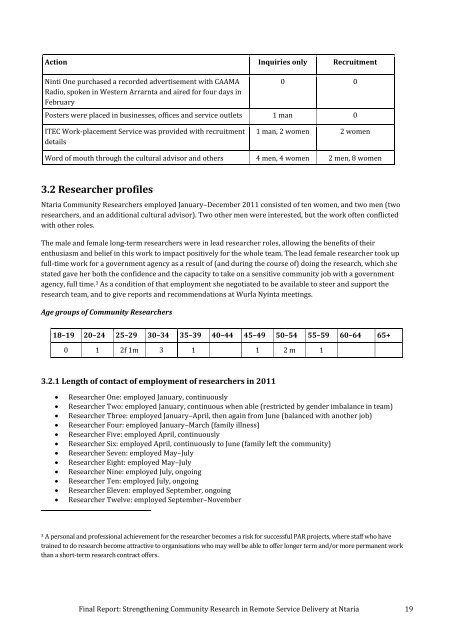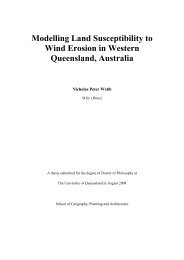Final Report: Strengthening Community Research in ... - Ninti One
Final Report: Strengthening Community Research in ... - Ninti One
Final Report: Strengthening Community Research in ... - Ninti One
You also want an ePaper? Increase the reach of your titles
YUMPU automatically turns print PDFs into web optimized ePapers that Google loves.
Action Inquiries only RecruitmentN<strong>in</strong>ti <strong>One</strong> purchased a recorded advertisement with CAAMARadio, spoken <strong>in</strong> Western Arrarnta and aired for four days <strong>in</strong>February0 0Posters were placed <strong>in</strong> bus<strong>in</strong>esses, offices and service outlets 1 man 0ITEC Work-placement Service was provided with recruitmentdetails1 man, 2 women 2 womenWord of mouth through the cultural advisor and others 4 men, 4 women 2 men, 8 women3.2 <strong>Research</strong>er profilesNtaria <strong>Community</strong> <strong>Research</strong>ers employed January–December 2011 consisted of ten women, and two men (tworesearchers, and an additional cultural advisor). Two other men were <strong>in</strong>terested, but the work often conflictedwith other roles.The male and female long-term researchers were <strong>in</strong> lead researcher roles, allow<strong>in</strong>g the benefits of theirenthusiasm and belief <strong>in</strong> this work to impact positively for the whole team. The lead female researcher took upfull-time work for a government agency as a result of (and dur<strong>in</strong>g the course of) do<strong>in</strong>g the research, which shestated gave her both the confidence and the capacity to take on a sensitive community job with a governmentagency, full time. 3 As a condition of that employment she negotiated to be available to steer and support theresearch team, and to give reports and recommendations at Wurla Ny<strong>in</strong>ta meet<strong>in</strong>gs.Age groups of <strong>Community</strong> <strong>Research</strong>ers18–19 20–24 25–29 30–34 35–39 40–44 45–49 50–54 55–59 60–64 65+0 1 2f 1m 3 1 1 2 m 13.2.1 Length of contact of employment of researchers <strong>in</strong> 2011<strong>Research</strong>er <strong>One</strong>: employed January, cont<strong>in</strong>uously<strong>Research</strong>er Two: employed January, cont<strong>in</strong>uous when able (restricted by gender imbalance <strong>in</strong> team)<strong>Research</strong>er Three: employed January–April, then aga<strong>in</strong> from June (balanced with another job)<strong>Research</strong>er Four: employed January–March (family illness)<strong>Research</strong>er Five: employed April, cont<strong>in</strong>uously<strong>Research</strong>er Six: employed April, cont<strong>in</strong>uously to June (family left the community)<strong>Research</strong>er Seven: employed May–July<strong>Research</strong>er Eight: employed May–July<strong>Research</strong>er N<strong>in</strong>e: employed July, ongo<strong>in</strong>g<strong>Research</strong>er Ten: employed July, ongo<strong>in</strong>g<strong>Research</strong>er Eleven: employed September, ongo<strong>in</strong>g<strong>Research</strong>er Twelve: employed September–November3 A personal and professional achievement for the researcher becomes a risk for successful PAR projects, where staff who havetra<strong>in</strong>ed to do research become attractive to organisations who may well be able to offer longer term and/or more permanent workthan a short-term research contract offers.<strong>F<strong>in</strong>al</strong> <strong>Report</strong>: <strong>Strengthen<strong>in</strong>g</strong> <strong>Community</strong> <strong>Research</strong> <strong>in</strong> Remote Service Delivery at Ntaria 19
















